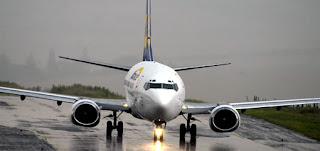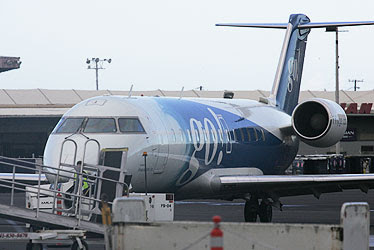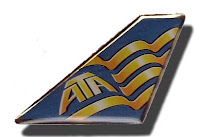 Another airline has abruptly gone out of business: South African low-fare carrier Nationwide Airlines, in business since 1991, announced yesterday that they are ceasing operations. Regular readers of Aircrew Buzz may remember the incident reported here last November in which an engine separated from a Nationwide Boeing 737-200 on takeoff, just after rotation. The crew were able to return the aircraft to the airport at Cape Town and land it safely, with no injuries to anyone on board, however that incident seemed to be the tipping point that ultimately led to the demise of Nationwide Airlines, according to the company.
Another airline has abruptly gone out of business: South African low-fare carrier Nationwide Airlines, in business since 1991, announced yesterday that they are ceasing operations. Regular readers of Aircrew Buzz may remember the incident reported here last November in which an engine separated from a Nationwide Boeing 737-200 on takeoff, just after rotation. The crew were able to return the aircraft to the airport at Cape Town and land it safely, with no injuries to anyone on board, however that incident seemed to be the tipping point that ultimately led to the demise of Nationwide Airlines, according to the company.A message posted on the Nationwide Airlines website on April 29, 2008 explains things this way:
On the 7th November 2007, Nationwide Airlines experienced an engine separation from a Boeing 737-200 on departure from Cape Town.Business news network Bloomberg is reporting that Nationwide has asked the South African high court to appoint a liquidator to manage the sale of the airline's assets.
Subsequent to this a protracted grounding of our fleet was mandated by the South African Civil Aviation Authority.
In the months of December and January we resumed operations and attained a gradual recovery of the business however in the months of March and April we faced a 30% increase in fuel costs coupled with a decrease in passenger load factors.
Throughout this period we continued to work towards securing investment by a black empowerment consortium which unfortunately has not come to fruition.
Our cash-flow has become critical and as a result have decided to voluntarily cease all flight operations until further notice.
We apologize to our loyal customers for any and all inconveniences experienced.
The notice on Nationwide's website made no mention of the airline's employees, or their fate, but the Bloomberg article said:
Workers at Nationwide "are extremely traumatized by what has happened," United Association of South Africa, a labor union that represents 83,000 workers in 30 industries including transport, mining, security and engineering, said in an e-mailed statement. Competitors such as Comair, Airlink and SA Express have invited Nationwide employees to apply for jobs, it said.The South African news website Independent Online (IOL) elaborated a bit on the situation for Nationwide Airlines employees:
The United Associations of South Africa, which represents about 200 Nationwide employees, wrote a letter to the airline on Wednesday saying that they had spoken to AGE group chief executive officer Reggie Naidoo and that he had expressed the possibility of salvaging the airline and saving jobs.Various news reports have stated that Nationwide continued to book flights and collect payment for fares right up to the time that the 'going out of business' message went up on the airline's website, and that passengers were left stranded when the Nationwide abruptly ceased operations.
However, because they had not had any feedback from their attempts at communicating with the airline, they had begun legal proceedings against the company to protect members.
The Airline Pilots Association said it was shocked by developments and to help the 68 member pilots at the airline, would cover their union subscriptions for the next three months and help them send out their CVs.
According to IOL, the International Air Transport Association (IATA) withheld all ticket sales payments due to Nationwide when the airline announced that it had closed.
"IATA is monitoring the situation closely and will make every effort to meet with Nationwide as soon as possible to agree how the money we are holding will be used," the association said.
Good luck to IATA for trying to arrange such a meeting: The IOL article also mentioned that Nationwide's office phones, as well as the cellphones of directors and chief executive officer Vernon Bricknell, were not being answered.
[Photo Source]

























